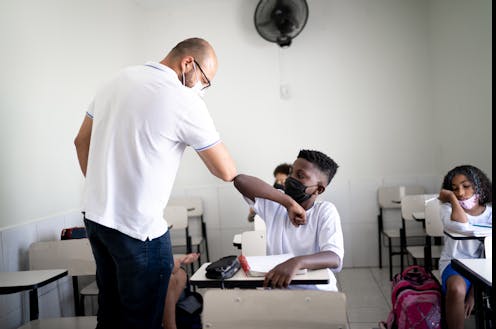Students are suspended less when their teacher has the same race or ethnicity
- Written by Matthew Shirrell, Assistant Professor of Educational Leadership and Administration, George Washington University

The Research Brief is a short take about interesting academic work.
The big idea
Black, Latino and Asian American students are less likely to be suspended from school when they have more teachers who share their racial or ethnic background. This is the central finding of a research study[1] that two colleagues – Travis J. Bristol[2] and Tolani Britton[3] – and I released in October 2021 through the Annenberg Institute for School Reform at Brown University.
To figure out if a teacher’s race or ethnicity affected suspensions, we analyzed 10 years of data – from 2007 through 2016 – on suspensions for every student in fourth through eighth grades in New York City public schools. We followed individual students over time. We examined whether the proportion of teachers of the same race or ethnicity these students were assigned in a given year affected how likely they were to be suspended.
We found that the decrease in suspension likelihood caused by having teachers of the same race or ethnicity as students was roughly the same magnitude for Asian, Black and Latino students – about 3%.
Our results suggest that if the representation of Black teachers for Black students in New York City went from 40% to 80%, and from 20% to 50% for Latino teachers for Latino students, suspension rates for Black and Latino students would drop by roughly 3%. This is because the percentage of Black teachers overall in New York City is not 40% — that is the percentage of Black teachers for Black students in the city, according to our estimates. Similarly, we found that 20% is the percentage of Latino teachers for Latino students.
Such a change during the decade we studied would have resulted in 1,800 fewer suspensions of Black students and 1,600 fewer suspensions of Latino students, with these students spending approximately 9,000 and 8,000 more days in their classrooms, respectively.
Why it matters
Black and Latino students are suspended from school at higher rates than their white peers[4].
These disparities are apparent as early as preschool[5]. The disparities are connected to lower academic achievement[6] and lower levels of civic participation later in life[7].
Although Black and Latino students comprise 43% of public school students nationwide[8], the teacher workforce is only 16% Black or Latino[9]. Compared with white teachers, racially and ethnically matched teachers have been found to raise student test scores[10] and improve the chances of graduating from high school and attending college[11]. The relative lack of Black and Latino teachers who teach Black and Latino students, then, could also contribute to racial and ethnic disparities in school suspensions.
What still isn’t known
Our findings demonstrate the importance of learning more about the effectiveness of efforts to hire and retain teachers of color[12]. Our findings also show the importance of investigating why Black, Latino and Asian American students are less likely to be suspended from school when they are taught by teachers who share their racial and ethnic backgrounds. Learning about the practices of these teachers will help educators design training for teachers that can help all teachers – regardless of their backgrounds – approach student discipline in ways that do not harm students of color.
[More than 140,000 readers get one of The Conversation’s informative newsletters. Join the list today[13].]
References
- ^ a research study (doi.org)
- ^ Travis J. Bristol (gse.berkeley.edu)
- ^ Tolani Britton (gse.berkeley.edu)
- ^ suspended from school at higher rates than their white peers (doi.org)
- ^ as early as preschool (www.researchgate.net)
- ^ lower academic achievement (doi.org)
- ^ lower levels of civic participation later in life (doi.org)
- ^ 43% of public school students nationwide (nces.ed.gov)
- ^ only 16% Black or Latino (nces.ed.gov)
- ^ raise student test scores (doi.org)
- ^ improve the chances of graduating from high school and attending college (www.nber.org)
- ^ efforts to hire and retain teachers of color (nycmbk.org)
- ^ Join the list today (memberservices.theconversation.com)
Authors: Matthew Shirrell, Assistant Professor of Educational Leadership and Administration, George Washington University

